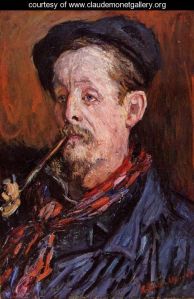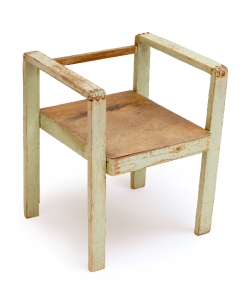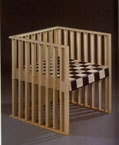Koloman Moser: From Impressionism to Bauhaus
- Introduction: Historical information and thesis.
Koloman Moser – born March 30th 1868, Vienna, Austria – died October 18th 1918, Vienna, Austria – he was one of the leading founders of the Vienna Secession, an artist group that opposed the traditionalism of the time in Austria. In 1905 he left the Secession together with Gustav Klimt and other artists to form the Wiener Werkstatte (in English: Vienna Workshop). An article by Karolinsky (http://woka.com/en/info/assosiation/wiener-werkstaette.asp, no date) describes the Vienna Workshop’s goal as “to make all facets of human life into one unified work of art.”
His first paintings were influenced by impressionism, but he later began to be influenced by the symbolist Ferdinanad Hodler. He also designed various furniture which suggest the beginnings of Bauhaus and was involved in works of architecture, for example, the Steinhof Church where he designed a mosaic, as well as the stained glass windows.
From these, we deduct that Moser made a transition from impressionism to the very start of the Bauhaus concept, the difference being that Bauhaus was directed towards mass manufacture, whereas Moser wanted to bring value to the uniqueness of each creation and bring crafts to the same level art was on.
2. Moser and Impressionism
Impressionism is described as (Encyclopaedia Britannica, 2011) “an attempt to accurately and objectively record visual reality in terms of transient effects of light and colour.” These characteristics can be easily found in Moser’s first works. For example, in his “Female Nude with Blue Shawl” (Fig.1) we can clearly see he was trying to catch the light on the canvas as accurately as possible, in order to reproduce the effect of shining skin. This is a clear sign that he was reproducing and not bringing his own influence inside of the picture, typical for an impressionist artist. Also, the texture of the coat the woman is sitting on is painted so that the viewer observes where the light falls upon it. This painting can be compared to Claude Monet’s “” (Fig. 2), through how the effect of the light on skin is reproduced and, the very same effect on the character’s coat is used to show where the light hits the material.
3. Moser and the beginning of Bauhaus
Bauhaus was a school where design , architecture, and applied arts were studied in Germany from 1919 to 1933. This school sought to reach its goal: “by training students equally in art and in technically expert craftsmanship […] to end the schism between the two” (Encyclopaedia Britannica, 2011), as an article states.
In a large view, that was exactly what the Wiener Werkstatte was aiming for, also. Only that they sought to make craftsmanship as refined and technical as painting, thus bringing beauty to the world through making unique pieces. Karolinsky (http://woka.com/en/info/assosiation/wiener-werkstaette.asp, no date) sais in the same article cited above: “This began with the creation of – for that time extraordinarily – advanced working conditions for the craftsmen, and it ended with the wish to create everything entirely anew, whether or not it was needed for everyday use or should act as decoration.” (Encyclopedia britannica, 2011)
Thus, these two groups of artists were experimenting with the same concepts, only that Bauhaus wanted to design them for efficiency of mass production. Let’s look at Dieckmann’s chair design (Fig. 3) and compare it to one of Moser’s own design, “The Rich Catch of Fish” (Fig. 4). We can observe the same straight 90 degree angles and the same way materials are not overused. They are used sparingly, because both movements had in mind the efficiency of design in this way. Of course, Moser’s chair has his signature “checkered squares”, but the decorations are made on the space of the shape in order to not complicate the process too much. Koloman obviously combined utility with the overall artistic presence of the chair. The checkered parts of the design are an organic part of the shape and compliments all the other straight angles, while Dieckmann subtracts all that is not necessary from the design, like the decorations and the slightly larger backrest to make the manufacture process less time-consuming and more economical.
4. Conclusion
We can now state that Koloman Moser did start out as an impressionist, but soon became tuned to the Secession’s anti-traditionalism and, as one of the founders of the Wiener Werkstatte, truly followed the group’s “goal of restoring the values of handcraftsmanship to an industrial society in which such crafts were dying” (Encyclopaedia Britannica, p. 2056) and that the group, implicitly through Moser with his “checkered” style of decorating furniture (Fig.5) influenced the Bauhaus movement of the 1920s.
Reference List:
1. http://woka.com/en/info/assosiation/wiener-werkstaette.asp (no date) (accessed: 31st March 2010)
2. Encyclopedia Britannica (2011) Impressionism. [Online] Available at: http://www.britannica.com/EBchecked/topic/284143/Impressionism (accessed 31st March 2010)
3. Fig. 1: Moser, K. (1913) Female Nude With Blue Shawl. [Online] Available at: http://farm4.static.flickr.com/3299/3525868964_44f12097ac_z.jpg (accessed 31st March 2010)
4. Fig. 2: Monet, C. (1879) Leon Peltier. [Online] Available at: http://www.monetpainting.net/paintings/images/pipeold.jpg (accessed 31st March 2010)
5. Encyclopedia Britannica (2011) Bauhaus. [Online] Available at: http://www.britannica.com/EBchecked/topic/56418/Bauhaus (accessed 31st March 2010)
6. http://woka.com/en/info/assosiation/wiener-werkstaette.asp (no date) (accessed: 31st March 2010)
7. Fig. 3: Dieckmann, E. (ca. 1920) Bauhaus Kinderstuhl. [Online] Available at: http://daddytypes.com/archive/dieckmann_chair_auktionen.jpg (accessed 31st March 2010)
8. Fig. 4: Moser, K (1900) The Rich Catch of Fish. [Online] Available at: http://collectionsonline.lacma.org/MWEBimages/decarts03_mm/full/M2000_180_39.jpg (accessed 31st March 2010)
9. Fig. 5: Moser, K (1902) Armchair for the Purkersdorf Sanatorium. [Online] Available at: http://designmuseum.org/media/item/72002/869/56_3.jpg (accessed 31st March 2010)




